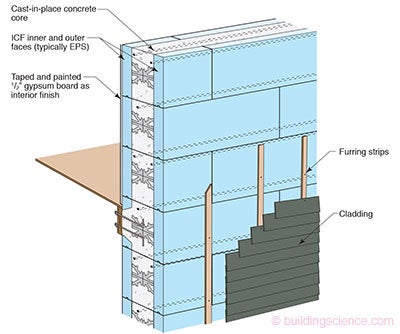This overview summarizes ICF wall construction including the advantages and disadvantages of this construction strategy. Complex two dimensional heat flow analysis and one dimensional hygrothermal modeling were used to determine moisture related durability risks for analysis.

- Cladding
- Furring strips creating a minimum 3/8" ventilation gap/drainage gap behind cladding
- Cast-in-place concrete core with ICF inner and outer faces; typically EPS, and less commonly cement wood fiber
- Interior gypsum wall board
Thermal Control
Installed insulation R-value: R-values of Insulated Concrete Form construction vary considerably with the type and thickness of form. The most common ICF form is constructed of EPS insulation in the range of 21/2” thick on the interior and exterior. Other ICF materials include cementitious wood based forms, some of which are constructed with an extra layer of insulation (e.g. Rockwool) in the form.
Whole-wall R-value: Using two-dimensional heat flow analysis shows that there are few thermal bridges from the interior to the exterior on an ICF wall. A 9” foam ICF form with 5” of EPS has a whole-wall R-value of approximately R-20.
Air Leakage Control: he concrete core in ICF construction forms an air barrier in the field of the wall. Air leakage will occur at penetrations through the wall if they are not detailed correctly.1
Typical Insulation: EPS foam insulation forms and, less commonly, cementitious wood based forms.
Durability
Rain Control: Rain leakage into the enclosure is the leading cause of premature building enclosure failure. Rain control is typically addressed using the face of the ICF. Intersections, windows, doors and other penetrations must be drained and/or detailed to prevent the penetration of rainwater beyond the water control layer.2 There is little to no moisture buffering capacity of an ICF wall so even a minimal amount of water, undetectable in standard construction, will have durability issues in ICF construction.
Air Leakage Control: ICF construction forms an air barrier in the field of the wall. All through wall penetrations require air sealing details.3
Vapor Control: There are no significant risks to moisture durability from vapor drive in ICF construction. Both the concrete core and foam skins provide sufficient vapor diffusion resistance to control condensation of vapor driven from either side.
Drying: ICFs will dry both to the interior and exterior depending on climate and time of year.
Built-in Moisture: Since ICFs are poured concrete walls in forms with relatively low vapor permeance surfaces, the concrete will dry very slowly. The permeability of the ICF materials reduces the drying rate such that the interior finishes are protected from damage.
Durability Summary: TThere are very few risks associated with air leakage and vapor condensation of ICF construction. The ICF wall itself is not susceptible to moisture related issues but interior finishes are generally sensitive to moisture.
Buildability
Generally, building with ICFs is quite easy and straightforward following initial training. Problems in the past have occurred with air pockets in the forms, as well as bulging and breaking of forms due to the hydrostatic pressure of concrete. These problems are well documented and there are strategies to address these issues.
Cost
The cost of ICF construction varies considerably depending on the type of forms chosen, geometry of construction and location. ICF construction is more expensive than standard construction.
Material Use
ICF walls use less concrete than an alternative wall built entirely with concrete, and concrete is very high in embodied energy. The wood framing can be minimized by attaching the drywall directly to the ICF block on the interior.
Summary
ICF construction is a very durable construction strategy provided the rainwater management details are constructed correctly. Generally, ICF construction alone cannot achieve a high R-value and will require other insulation strategies in combination for cold climates, which is commonly done in practice. ICFs are ideal for basements and multi-story residential and are being adopted as the dominant choice in some markets.
References
- Straube, J. (2009, 04 22). BSD-014 Air Flow Control in Buildings.
- Lstiburek, J. W. (2006). Water Management Guide.
- Lstiburek, J. (2008, 08 20). BSD-104: Understanding Air Barriers.
